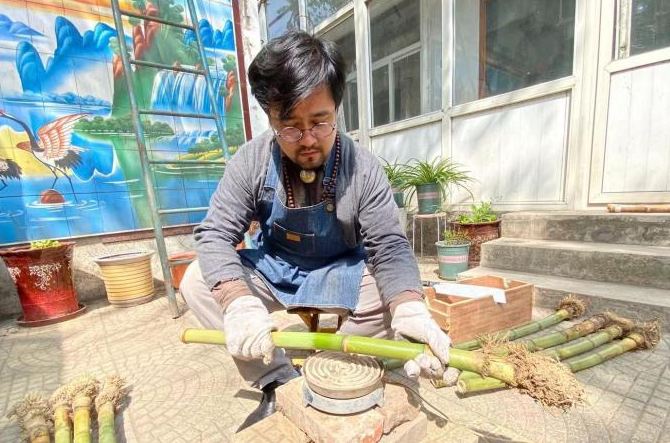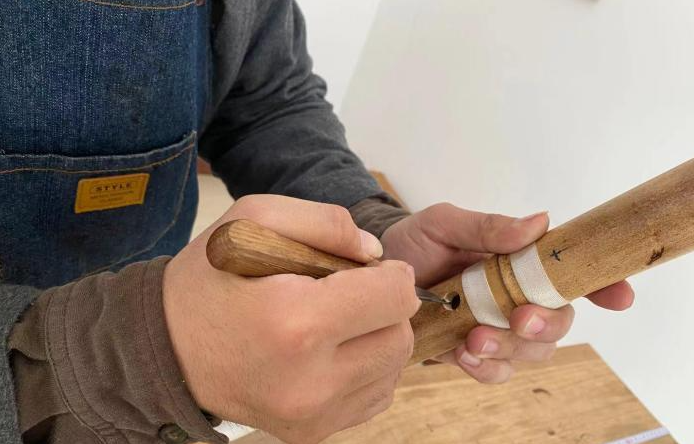"Post-85" Shakuhachi producer Cao Hao asked the world to reunite with the millennium "Tang Yin"

The picture shows Cao Hao "killing" bamboo.
The April sun shines on the ground like flowing water through the gaps in the leaves. Taking advantage of the sunny weather, Cao Hao decided to "kill" the bamboo.
I saw Cao Hao turning the bamboo on the stove while wiping off the roasted bamboo oil until the bamboo turned from green to gray. "After at least one and a half to three years of drying and storage, as well as dozens of fine grinding processes, these bamboos may become the shakuhachi of the 'One Sound Entering the Forest Blowing Wrinkle Ancient Temple Sanskrit'," said Cao Hao.
"When it comes to shakuhachi, many young people think of Japan or the soundtrack of "Naruto". In fact, shakuhachi is something from China." Cao Hao, 35, is a guqin teacher in Shijiazhuang and a shakuhachi maker.
According to Cao Hao, the shakuhachi is a traditional Chinese musical instrument made of bamboo. It is named after the length of one foot eight inches. The "Puhua Shuba" he is making now originates from the Linji Temple in Zhengding, Shijiazhuang.
"Traditional shakuhachi production attaches great importance to the 'talent' of bamboo." Cao Hao, who is adjusting and adjusting the diameter of the shakuhachi, said that the sound of the shakuhachi is desolate and vast, with an ethereal and tranquil artistic conception, so the requirements for bamboo are extremely high. In order to find the bamboo material that reproduces the "prosperous Tang Yin", he has traveled to the bamboo forests in Guilin, Hangzhou and other places many times. "It is good luck to find 10 bamboos after turning over a mountain. Sometimes good bamboos may not be found, but encountered wild boar".

The picture shows Cao Hao repairing the hole in the shakuhachi
In order to let more people know about shakuhachi, in 2021, Cao Hao established a shakuhachi workshop to teach people the skills of shakuhachi for free. There are now more than 30 students, a large part of which are "post-90s".
Every Sunday morning, Cao Hao will lead the students to walk in the wide field while playing shakuhachi to improve their strength. "In addition to practicing shakuhachi, playing shakuhachi can also exercise spirit and spirit, and it can improve young people's lack of concentration and other problems." Cao Hao is good at shakuhachi. level, the two complement each other.
Feng Ziyuan, who has studied shakuhachi with Cao Hao for 4 years, is preparing for the postgraduate exam. "I would take a musical instrument to school to play, and many students would ask curiously what it was when they saw it, and also try to play it." Feng Ziyuan said that he would also like to learn shakuhachi making and inherit traditional shakuhachi culture in the future.
In recent years, shakuhachi music has been used in film and television works such as "The Legend of the Demon Cat", and the documentary-style film "Shakuhachi: A Sound of Life" has aroused discussions among young people on social networking sites.
"Although shakuhachi is gradually being recognized by more people, there are indeed practical difficulties." Cao Hao said that traditional shakuhachi is currently very small in China and is still in the "awakening" stage. When he communicated in Japan, he learned that there are very few people playing traditional shakuhachi in Japan today. "Actually, this is an opportunity for traditional shakuhachi to return to its Chinese origin."
"The best state is to let the traditional shakuhachi return to China, and then be inherited and fermented by the Chinese." After speaking, Cao Hao blew the newly made shakuhachi. In the melodious air waves, I seem to hear the wind of the Tang Dynasty blowing through the bamboo forest, blowing away the burial of the heavy history, and letting the world meet the thousand-year-old "Tang Yin" again.
 渝公网安备 50010702504639号
渝公网安备 50010702504639号